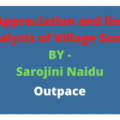THE POET

Rabindranath Tagore
Born – May 7, 1861, Calcutta, British
India.
Died – August 07, 1941, Calcutta British
India
He was a man with multifarious abilities.
He was a true scholar who contributed extensively to poetry, short story, song
composition, novel writing as a playwright, essayist and as a painter.
Notable works – 1) Gitanjali
more….
Awards – 1) Nobel Prize in Literature in 1913.
in 1915.
Where knowledge is free
Where the world has not been broken up into fragments
By narrow domestic walls
Where words come out from the depth of truth
Where tireless striving stretches its arms towards perfection
Where the clear stream of reason has not lost its way
Into the dreary desert sand of dead habit
Where the mind is led forward by thee
Into ever-widening thought and action
Into that heaven of freedom, my Father, let my country awake.
THE POEM
the Mind is Without Fear” is one of the most celebrated poems of Tagore.
Tagore. The poem takes us to different realm where the poet acquaints us with
Tagore’s dream of India. His dream is about new and awakened India. He tells us
about being free not only from foreign rule but also from the dogmatic coercion.
He asks his countrymen to get nourished by true freedom which enables one with
many positive qualities like fearlessness, broad mindedness, liberal state of
mind, dignity simplicity and sincerity.

OF THE POEM
poem was first composed in 1900 and first appeared in the volume of ‘Naivedya’
in the month of July 1901. Later it was recorded as the poem no. 36 in Tagore’s
world famous work “Gitanjali” in 1912.
DEVICES USED
Where the mind is without fear and
the head is held high
the world has not been broken up into fragments
Where the words came out from the
depth of truth
arms towards perfection.
the clear stream of reason has not lost its way.
Into ever widening thought and action
my father, let my country awake.
Held high
Clear stream of reason
b) dreary desert of dead habit
“A tireless striving stretches its arms
towards perfection”.
THE MIND IS WITHOUT FEAR
POEM OF PRAYER
find this very poem in the volume of “Naivedya”. And the title of the original
poem is “Prarthana”. Tagore here prays to the Almighty with some innate
desires. He wishes that the motherland must achieve freedom, progress and
happiness free from fear and all kinds of pessimistic aspects. Prayer to God is
to bestow true knowledge to all individuals, to unite all the religions. Above
all the prayer is to awaken India to its heavenly state.

FREEDOM WITHOUT FEAR
poem was written during the British Rule in India. Common
people of India were under suppression. Tagore aspired his countrymen to attain
total freedom. He did not only aspire free from the rule of the British, rather
he wanted his countrymen to be free in all aspects-such as political,
intellectual, religious, moral and so on.






thank you! this helped me very much
Your welcome
Brozi kannan